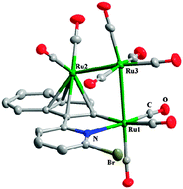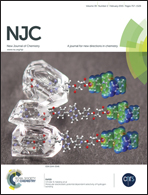Reactivity of a trinuclear ruthenium complex involving C–H activation and insertion of alkene†
Abstract
A novel pyridyl-substituted indenyl trinuclear ruthenium complex, {μ2-η5:η1-(C5H3N-6-Br)(C9H5)}Ru3(CO)9 (1), was synthesized by thermal treatment of 1-(6-bromo-2-pyridyl)indene with Ru3(CO)12 (1 : 1 mol ratio) in refluxing heptane and its reactivity with pyridine derivatives, toluene, indene, fluorene, phenylethylene and divinylbenzene was studied. The reaction of 1 with 5-fold excess of 1-(6-bromo-2-pyridyl)indene gave two products, complex {η5-(C5H3N-6-Br)(C9H5)}{η1-(C5H3N)(C9H6)}Ru2(CO)4 (2) and substituted dibenzfulvalene (3). Reaction of 1 in refluxing toluene afforded an unexpected complex {μ3-η6:η3:η1-(C5H3N-6-Br)(C9H5)}Ru3(CO)7 (4), via the loss of two CO groups. Reaction of 1 with indene in refluxing heptane afforded a known complex [{(η5-C9H7)Ru(CO)2}2] (5). The reaction of 1 with fluorene in refluxing heptane afforded complex {μ3-η6:η3:η1-(C5H3N-6-Br)(C9H5)}Ru3(CO)7 (4), fluorene was not involved in the reaction, indicating that the reactivity of fluorene is low. The reactions of 1 with phenylethylene or divinylbenzene in refluxing toluene gave the dinuclear ruthenium complexes {η5-(C5H3N-6-Br)(C9H5CHCH2Ph)}Ru2(CO)5 (6) and {η5-(C5H3N-6-Br)(C9H5CHCH2PhCHCH2)}Ru2(CO)5 (7), respectively. These complexes have been characterized by elemental analysis, IR, and 1H NMR spectroscopy. The molecular structures of 1–6 were determined by X-ray diffraction. The density functional theoretical calculations on the electronic structure of complex 1 give an illustration to its high reactivity.


 Please wait while we load your content...
Please wait while we load your content...